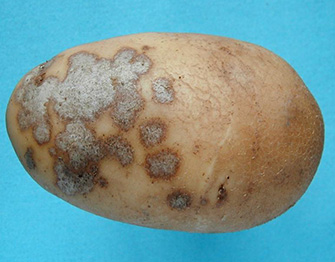Please click here to access the main AHDB website and other sectors.
- Home
- Knowledge library
- Silver Scurf
Silver Scurf

Silver scurf (Helminthosporium solani) is a ubiquitous fungal blemish disease of potatoes.
Conditions
Infection can originate from seed tubers, the soil or from spores remaining in store. Symptoms are normally present at harvest but the disease develops in store. Affected skin is weakened, prone to scuffing and can wrinkle due to moisture loss.
The longer tubers remain in the soil, the more likely silver scurf is to become a problem. High humidity and temperature encourages disease development during storage. The biggest problem is condensation this occurs where warm air meets cool tubers.
Symptoms
It is first visible as small silvery grey spots that enlarge into circles, which may show a slightly darker margin. Under optimal conditions (moist and warm) these circles grow, and merge together. A pattern of coalescing discs is distinctive but not always evident. During prolonged storage the colour may “tarnish” to a darker grey or brown.
Unwashed tubers affected by silver scurf often have a sooty appearance caused by spore development. To confirm the presence of silver scurf look for tiny, short, black threads at a magnification of 10x. These are the distinctive conidiophores on which spores grow. Spores are easily blown or washed off but many conidiophores are likely to remain unless scrubbed excessively.
Silver scurf may be confused with black dot, which can sometimes appear silvery. The diseases frequently occur on the same tuber, but rarely overlap. Confusion is less likely where the diseases are seen side by side.
Silver scurf vs Black dot
- At 10x magnification, with a hand lens, short black thread-like structures are indicative of silver scurf. However, they do wash off very easily.
- At the same magnification Black dot appears as small, dispersed, black dots, sometimes as small as a skin cell. They are never dislodged by washing.
Control
Early lifting can reduce the incidence of silver scurf. Fungicidal treatment of tubers prior to planting or at harvest (into store) may prevent infection. Rapid temperature pull-down (0.5 C/day) retards disease development. In store, it is essential to avoid condensation and positive ventilation minimises this risk. Routine annual store cleaning is advisable.

